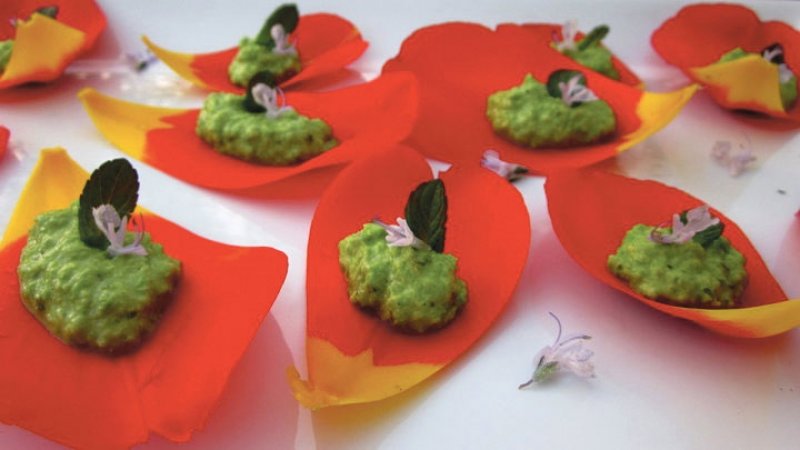When we hear the word “foraging,” some of us think about hiking through the woods, carefully picking the tender leaves of a stinging nettle or eating wild huckleberries straight from the bush.
Depending on your age, you might even think of the legendary Euell Gibbons in one of his many Grape-Nuts commercial, standing in a forest near a pine tree asking “Ever eat a pine cone? Many parts are edible.”But there are foraging opportunities right outside your front door: edible flowers.

Before we talk about which varieties of flowers are edible and how to prepare them, there are some important things to think about. Be sure any flowers you eat are free from pesticides or fertilizer residue and haven’t been marked by pets or wildlife. Your own garden is the best place to start when looking for edible flowers since you probably know whether they're safe or not.
Tulips, calendula, nasturtium, roses and lavender are a few of my favorites for recipes and garnishes.
To begin, cut flowers and place them on a moist paper towel, then put them in a sealed container in your refrigerator. Stored this way, some floral varieties will last up to 10 days. For best results, pick flowers first thing in the morning, when water content is highest. A good rule of thumb is to use only the petals of flowers. Other parts, like stamens, pistils and bulbs can be bitter or even toxic. Along those same lines, some edible flowers, like roses, dianthus, English daisies, marigolds and chrysanthemum have a bitter white portion as the base of the petal where it is attached to the flower. Snip or tear off the white part right before using in a recipe.
Tulip petals taste a bit like raw peas, baby lettuce or fresh cucumbers. It’s been said that red tulips are the most flavorful, but I haven’t done any side-by-side taste tests. Place a tulip petal on a pretty platter and, using a piping bag or a small spoon, put a marble-size dollop of herbed cream cheese or firm, commercially prepared dip in the center of the petal. Garnish the dollop with a sliver of a petal, or cut out a cute shape with scissors.
Calendula petals are peppery and can be eaten either fresh or dried. Dried calendulas hold their bright orange and yellow colors splendidly, for months and sometimes years, brightening even the gloomiest winter days. Use fresh or dried calendula mixed into soups and salads or on top as a colorful garnish.
Nasturtium petals are another peppery favorite, if you like that flavor profile. The beauty of nasturtiums is they come in a variety of colors and their leaves are edible too.
Roses can be used fresh or dried. The petals will vary greatly in taste, depending on the type of rose you try. Make a delicately flavored tea by adding a dozen or so fresh rose petals to a glass of boiling water. Wait until the water changes color. Add honey, if desired. Wonderful hot or iced. Another old-fashioned favorite, candied rose petals are a gorgeous way to take any dessert to the next level.
Lavender is another flower that can be used dried or fresh. Their tiny blooms add a citrusy note in sweet or savory dishes. Be sure to use a lavender cultivar like Hidcote or Munstead or the results of your labor will taste like soap. If you don’t know what kind of lavender you're growing, pull a single bud off your plant, crush it with your fingers and smell it. If the scent is perfume-like you should probably save it for sachets. If not, go ahead and taste it. If it tastes good to you, it will probably be perfect for your recipe. A simple way to use lavender is to stick a sprig in your lemonade or place a few buds in granulated sugar to infuse it, then use it to sweeten ice tea or top sugar cookies.
Spring is here. Step outside and start sampling.
 Before we talk about which varieties of flowers are edible and how to prepare them, there are some important things to think about. Be sure any flowers you eat are free from pesticides or fertilizer residue and haven’t been marked by pets or wildlife. Your own garden is the best place to start when looking for edible flowers since you probably know whether they're safe or not.
Tulips, calendula, nasturtium, roses and lavender are a few of my favorites for recipes and garnishes.
To begin, cut flowers and place them on a moist paper towel, then put them in a sealed container in your refrigerator. Stored this way, some floral varieties will last up to 10 days. For best results, pick flowers first thing in the morning, when water content is highest. A good rule of thumb is to use only the petals of flowers. Other parts, like stamens, pistils and bulbs can be bitter or even toxic. Along those same lines, some edible flowers, like roses, dianthus, English daisies, marigolds and chrysanthemum have a bitter white portion as the base of the petal where it is attached to the flower. Snip or tear off the white part right before using in a recipe.
Tulip petals taste a bit like raw peas, baby lettuce or fresh cucumbers. It’s been said that red tulips are the most flavorful, but I haven’t done any side-by-side taste tests. Place a tulip petal on a pretty platter and, using a piping bag or a small spoon, put a marble-size dollop of herbed cream cheese or firm, commercially prepared dip in the center of the petal. Garnish the dollop with a sliver of a petal, or cut out a cute shape with scissors.
Calendula petals are peppery and can be eaten either fresh or dried. Dried calendulas hold their bright orange and yellow colors splendidly, for months and sometimes years, brightening even the gloomiest winter days. Use fresh or dried calendula mixed into soups and salads or on top as a colorful garnish.
Nasturtium petals are another peppery favorite, if you like that flavor profile. The beauty of nasturtiums is they come in a variety of colors and their leaves are edible too.
Roses can be used fresh or dried. The petals will vary greatly in taste, depending on the type of rose you try. Make a delicately flavored tea by adding a dozen or so fresh rose petals to a glass of boiling water. Wait until the water changes color. Add honey, if desired. Wonderful hot or iced. Another old-fashioned favorite, candied rose petals are a gorgeous way to take any dessert to the next level.
Lavender is another flower that can be used dried or fresh. Their tiny blooms add a citrusy note in sweet or savory dishes. Be sure to use a lavender cultivar like Hidcote or Munstead or the results of your labor will taste like soap. If you don’t know what kind of lavender you're growing, pull a single bud off your plant, crush it with your fingers and smell it. If the scent is perfume-like you should probably save it for sachets. If not, go ahead and taste it. If it tastes good to you, it will probably be perfect for your recipe. A simple way to use lavender is to stick a sprig in your lemonade or place a few buds in granulated sugar to infuse it, then use it to sweeten ice tea or top sugar cookies.
Spring is here. Step outside and start sampling.
Before we talk about which varieties of flowers are edible and how to prepare them, there are some important things to think about. Be sure any flowers you eat are free from pesticides or fertilizer residue and haven’t been marked by pets or wildlife. Your own garden is the best place to start when looking for edible flowers since you probably know whether they're safe or not.
Tulips, calendula, nasturtium, roses and lavender are a few of my favorites for recipes and garnishes.
To begin, cut flowers and place them on a moist paper towel, then put them in a sealed container in your refrigerator. Stored this way, some floral varieties will last up to 10 days. For best results, pick flowers first thing in the morning, when water content is highest. A good rule of thumb is to use only the petals of flowers. Other parts, like stamens, pistils and bulbs can be bitter or even toxic. Along those same lines, some edible flowers, like roses, dianthus, English daisies, marigolds and chrysanthemum have a bitter white portion as the base of the petal where it is attached to the flower. Snip or tear off the white part right before using in a recipe.
Tulip petals taste a bit like raw peas, baby lettuce or fresh cucumbers. It’s been said that red tulips are the most flavorful, but I haven’t done any side-by-side taste tests. Place a tulip petal on a pretty platter and, using a piping bag or a small spoon, put a marble-size dollop of herbed cream cheese or firm, commercially prepared dip in the center of the petal. Garnish the dollop with a sliver of a petal, or cut out a cute shape with scissors.
Calendula petals are peppery and can be eaten either fresh or dried. Dried calendulas hold their bright orange and yellow colors splendidly, for months and sometimes years, brightening even the gloomiest winter days. Use fresh or dried calendula mixed into soups and salads or on top as a colorful garnish.
Nasturtium petals are another peppery favorite, if you like that flavor profile. The beauty of nasturtiums is they come in a variety of colors and their leaves are edible too.
Roses can be used fresh or dried. The petals will vary greatly in taste, depending on the type of rose you try. Make a delicately flavored tea by adding a dozen or so fresh rose petals to a glass of boiling water. Wait until the water changes color. Add honey, if desired. Wonderful hot or iced. Another old-fashioned favorite, candied rose petals are a gorgeous way to take any dessert to the next level.
Lavender is another flower that can be used dried or fresh. Their tiny blooms add a citrusy note in sweet or savory dishes. Be sure to use a lavender cultivar like Hidcote or Munstead or the results of your labor will taste like soap. If you don’t know what kind of lavender you're growing, pull a single bud off your plant, crush it with your fingers and smell it. If the scent is perfume-like you should probably save it for sachets. If not, go ahead and taste it. If it tastes good to you, it will probably be perfect for your recipe. A simple way to use lavender is to stick a sprig in your lemonade or place a few buds in granulated sugar to infuse it, then use it to sweeten ice tea or top sugar cookies.
Spring is here. Step outside and start sampling.







